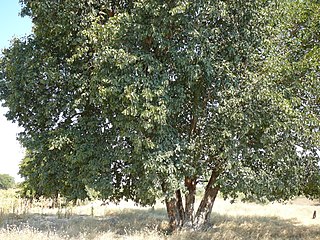
Meliaceae, the mahogany family, is a flowering plant family of mostly trees and shrubs in the order Sapindales.

Afzelia is a genus of plants in family Fabaceae. The thirteen species all are trees, native to tropical Africa or Asia.

Brachystegia is a genus of tree of the subfamily Detarioideae that is native to tropical Africa.

Cynometra is genus of tropical forest trees with a pantropical distribution.

Baikiaea is a genus of flowering plants in the legume family, Fabaceae. It includes six species of trees native to sub-Saharan Africa. Species range from Nigeria eastwards to Uganda and Tanzania and south to Zimbabwe, Botswana, and Namibia. Habitats range from lowland tropical rain forest to seasonally dry forest and woodland or savannas on well-drained soils.

Didelotia is a genus of flowering plants in the family Fabaceae. It includes 13 species native to western and west-central tropical Africa, ranging from Sierra Leone to the Democratic Republic of the Congo.
Englerodendron is a small genus of legumes belonging to the family Fabaceae, that are native to tropical Africa.

Gilbertiodendron is a genus of legume in the family Fabaceae. It consists of about 25 species of tree native to west and west-central tropical Africa. Members of this genus were formerly considered to be in the genus Macrolobium but that genus is now restricted to species growing in tropical America. It is closely related to Pellegriniodendron.
Gilletiodendron is a genus of plants in the family Fabaceae. It includes five species native to sub-Saharan Africa, which range from Côte d'Ivoire to DR Congo and Angola.

Hymenostegia is a genus of flowering plants in the family Fabaceae. It includes 14 species native to west and west-central tropical Africa.

Julbernardia is a genus of plants in the family Fabaceae. It includes ten species native to tropical Africa, ranging from Nigeria to Kenya, Mozambique, Botswana, Zambia and Namibia. They are medium-sized trees.
Loesenera is a genus of plants in the family Fabaceae. It includes four species of trees or shrubs native to west and west-central Africa, including Liberia, Côte d'Ivoire, Nigeria, Cameroon, Gabon, and Republic of the Congo. Its habitat is tropical lowland rain forest, typically along river banks and in swampy areas.

Schefflerodendron is a genus of flowering plants in the family Fabaceae. It includes four species of trees native to tropical Africa, ranging from Cameroon to Tanzania and Angola. They grow in tropical rain forest and seasonally-dry forest, including disturbed areas. Three species are native to the Guineo-Congolian forests of west-central Africa, and one species also extends to the Zanzibar-Inhambane coastal forests of Tanzania.
Tetraberlinia is a genus of plants in the legume family, Fabaceae. It includes species of trees native to west and west-central tropical Africa, including Liberia, Cameroon, Equatorial Guinea, Gabon, Republic of the Congo, Cabinda, and DR Congo. They grow in tropical lowland rain forest and riverine forest, often forming monodominant stands.
Zenkerella is a genus of plants in the family Fabaceae. It includes six species of evergreen trees native to tropical Africa. One species is native to Nigeria, Cameroon, and Gabon in west-central tropical Africa, where it grows in lowland, riverine, or swamp Guineo-Congolian forest. The other five species grow in Afromontane or coastal Zanzibar–Inhambane forest in Tanzania.
Stemonocoleus micranthus is a species of flowering plant in the legume family, Fabaceae. It is a tree native to western and west-central tropical Africa, ranging from Côte d'Ivoire to the Central African Republic and Republic of the Congo. It is a tree of the Guineo-Congolian forest, growing to 150 feet (46 m) high, with straight bole and buttresses. It is the sole species in genus Stemonocoleus. It belongs to subfamily Detarioideae.
Sindoropsis is a genus of flowering plants in the family, Fabaceae. It belongs to the subfamily Detarioideae. It contains a single species, Sindoropsis letestui, a tree native to Cameroon and Gabon in west-central Tropical Africa. It grows in tropical lowland rain forest.
Lebruniodendron is a genus of flowering plants in the family Fabaceae. It belongs to the subfamily Detarioideae. It contains a single species, Lebruniodendron leptanthum, a tree native to west-central tropical Africa – Cameroon, Gabon, Republic of the Congo, and Democratic Republic of the Congo. It grows in Guineo-Congolian forest.
Aphanocalyx is a genus of flowering plants in the family Fabaceae. It belongs to the subfamily Detarioideae. It includes 14 species native to tropical Africa, ranging from Sierra Leone to Côte d'Ivoire, and from Cameroon to Angola and Tanzania.
Baphiastrum is a genus of flowering plants in the legume family (Fabaceae). It includes a single species, Baphiastrum brachycarpum, a liana native to west-central Africa. It grows in Guineo-Congolian forest in Cameroon, Gabon, Republic of the Congo, Central African Republic, and Democratic Republic of the Congo.








